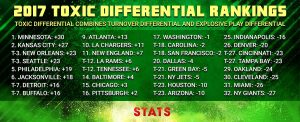Related Articles
Related Jobs
What makes up championship-level teams? It takes an offense that is dutiful to take care of the ball but also takes calculated shots down the field. It takes a ballhawking defense that keeps the offense in front of it.
All of that is considered in toxic differential rankings, which combines a team’s turnover differential and explosive play differential. Explosive plays are defined as those gaining at least 25 yards. If a team ends up with a positive toxic differential, odds are it had success on the field. End with a negative differential, and a team will end up higher in the draft order than it would probably like.
Ten of the top 13 teams in toxic differential ended up making the playoffs, with those three other teams – Seattle (plus-23), Detroit (+16), and Los Angeles Chargers (+11) – all winning nine games.
Eleven of the 12 playoff teams this season ended with a positive toxic differential, with Carolina being the only team on the negative side (at minus-2). Of the 17 teams in the NFL with a winning record in 2017, 15 of those had a positive differential, with Dallas joining Carolina below that separator (at -4).
On the flipside, 13 of the 14 teams with a losing record had a negative differential. The Chicago Bears were the only team with a positive differential (+3). For the sake of filling out the field, the Arizona Cardinals finished 8-8 with a -10 differential.
(Graphics by Stephan van Niekerk)
With all of that in mind, let’s take a look at some teams that improved their toxic differential drastically from 2016, some teams that went in the wrong direction, and some other interesting observations.
Trending Up
Philadelphia. Well, obviously. There’s a Super Bowl ring/”Let freedom ring”/Liberty Bell headline in there somewhere. But let’s just talk about the Eagles +19 differential this season, a high number and good enough for fifth in the NFL. Combined with the team’s -20 differential from 2016, the +39 jump the Eagles made was the highest of the 2017 season.
The Super Bowl champs improved in almost every category this season: 31 takeaways compared to 26 last year, 51 explosive plays compared to 41, and the defense allowed only 43 explosive plays, compared to 67 last season.
San Francisco. The 49ers ended the season at -2, but their five-game win streak to end the season coincided with an uptick in toxic differential. From the time Jimmy Garoppolo started his first game in Week 13 in Chicago, the 49ers were +10 in toxic differential. That number alone would have placed them 11th in the NFL.
After the team’s -32 finish in 2016, the +30 tick was pleasantly welcomed, and with Garoppolo at the helm under a new and lucrative deal announced Thursday, 49ers fans should have plenty of excitement heading into 2018.
Los Angeles Rams. The Rams followed a very similar path as the Eagles in 2017. Surround a second-year quarterback with plenty of weapons on offense and a stout defense. That led to the second-highest jump in toxic differential from 2016 to ’17. The Rams were 29th in 2016 (-26), and finished tied for 12th in head coach Sean McVay’s first season (+6).
McVay orchestrated the biggest offensive turnaround in league history, taking the lowest-scoring offense in 2016 and turning it into the highest-scoring offense one year later. That had never been done before. The Rams generated 38 explosive plays in 2016, and 57 in ’17.
It wasn’t just the offense, though. The defense forced 10 more turnovers than in 2016.
Detroit. Contrary to what Detroit teams are typically known for, it was the defense that carried the load for the Lions in 2017. Their 32 takeaways were third in the NFL, and the 44 explosive plays allowed by the defense was the ninth-lowest total.
Matthew Stafford and the offense were at the league average in turnovers (22) and were 15th in explosive plays (50). New head coach Matt Patricia is a defensive-minded guy, which made the retention of offensive coordinator Jim Bob Cooter all the more important if Detroit wants to take a step forward on that side of the ball.
The jump from a -5 toxic differential in 2016 to +16 this past season was a good starting point.
Chicago. As mentioned earlier, the Bears were the only team with a losing record with a positive toxic differential. They finished ahead of playoff participants Carolina and Pittsburgh, as well as Dallas and the Los Angeles Chargers.
That said, you’d be hard-pressed to find anyone to describe the Mitch Trubisky-led Bears offense as “explosive.” The rookie quarterback only threw 23 passes 21+ yards downfield this season. Because of that, the offense was 26th in explosive plays (39).
The defense was elite in keeping offenses in front of them, however. The 36 explosive plays they allowed were third in the league. Turnovers were a wash (they both forced and committed 22). For Bears fans wanting to replicate an Eagles/Rams turnaround with their second-year quarterback will be excited to know Chicago is well ahead of those two teams’ toxic differential pace from 2016 (as noted in the sections above).
Trending Down
Oakland. Jon Gruden has his work cut out for him next year in Oakland. The Raiders seem long removed from their playoff berth in 2016, when they sported a +18 toxic differential. This season, the team had a -24 differential. The -42 freefall the team made in toxic differential was easily the worst in the NFL.
Oakland didn’t finish better than 19th in takeaways, giveaways, turnover differential, explosive plays, explosive plays allowed or toxic differential. Last season, it was second in takeaways, tied for first in turnover differential, and tied for fifth in both explosive plays and toxic differential.
How’d Oakland go from 12-4 to 6-10, you ask? There’s your answer.
New England. Take this for what it’s worth: The Patriots were still a Hail Mary completion away from extending their chances for another Super Bowl win. However, there was no solid defense to lean back on this season.
The defense forced 23 turnovers in 2016 and allowed only 38 explosive plays. That was tied for the second-best total in the NFL. This season, though, the defense only forced 18 turnovers and gave up 55 explosive plays. That ultimately doomed the Patriots, as they gave up five explosive plays and 41 points in the Super Bowl.
Altogether, the Patriots’ toxic differential took a hit of -25 from 2016 to ’17.
Dallas. The Cowboys’ season possibly looks more disappointing simply because their 2016 season was so good in terms of toxic differential (+25, fourth in the NFL). And you can put some of this on Ezekiel Elliott missing time. He had 14 explosive runs in 2016 and only five in 2017.
But the defense doesn’t have that excuse, and that unit was nowhere close to as good as they were in 2016. After allowing 38 explosive plays in 2016, that number ballooned to 50 this year. Not so coincidentally, after being +20 in explosive differential in 2016, they fell to -3 in 2017.
New York Giants. Nothing really went right for the Giants this season. Fans could take pride in Eli Manning’s consecutive start streak, but that now stands at four after head coach Ben McAdoo benched Manning for one game in favor of Geno Smith in Week 13.
Injuries killed the Giants’ chances at being explosive on offense. Odell Beckham, Brandon Marshall and a handful of other playmakers went down. A bunch of unheard-ofs and rookies had to step up, and the Giants didn’t produce.
The 37 explosive plays were low, and the 61 explosive plays allowed were really high (31st in the league). That’s the main reason the Giants finished dead last in toxic differential this season (-27) – yes, worse than even the Cleveland Browns – a far cry from the +3 total from 2016, a year in which they made the playoffs.
By: Blake Dowson

